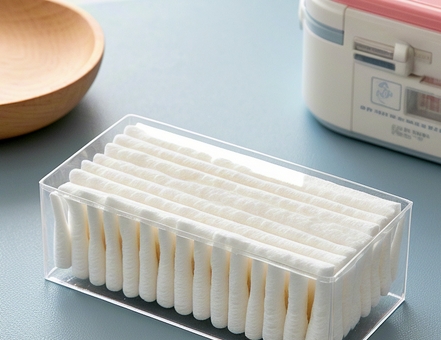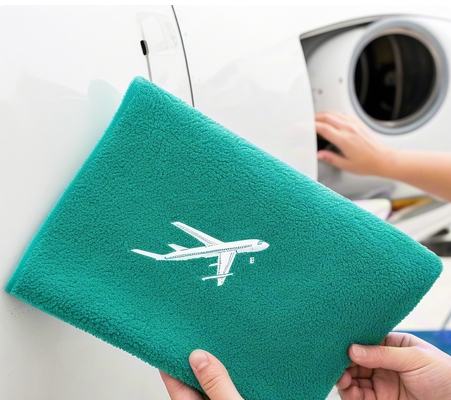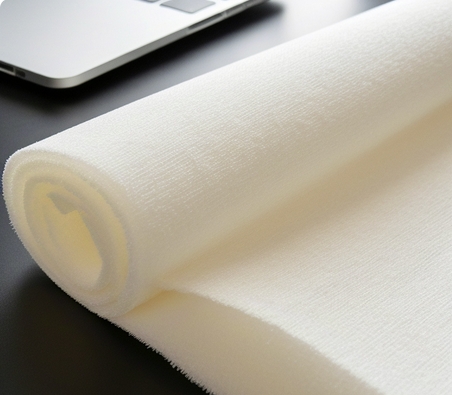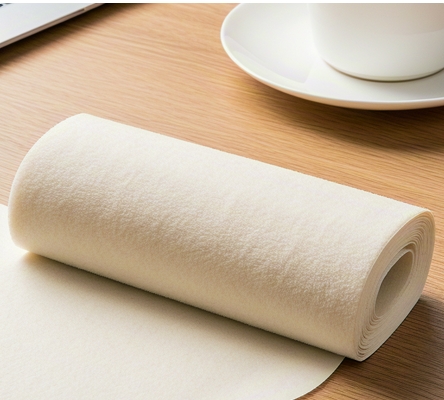Language

Technical specifications and in-depth interpretation of manufacturing process of a hundred-level dust-free cloth
As the core protective material of clean room environments, the level100-level dust-free cloth must strictly comply with the ISO 14644-1 Class 5 clean grade standards. The international specification requires that no more than 352 particles with a diameter of ≥0.5μm per cubic meter of air (equivalent to 100/cubic foot). This ultimate cleanliness demand has given rise to three core technical indicators: 0.2-1μm-grade fiber structure, quantifiable detection of ion precipitation control, and resistance to chemical reagents. Taking the semiconductor manufacturing workshop as an example, if a non-compliant dust-free cloth is used in its wafer cleaning process, it may cause more than 200 defect points per hour.
Analysis of key parameters for raw material selection. Continuous polyester filaments that meet IEST-RP-CC004.3 certification are the basic raw materials. The ultra-fine denier specification of 0.2-0.8 Daniel is like a precision screen, which can effectively block the penetration of fine dust. Comparative experimental data show that the particle release amount of fabrics using ASTM F51 standard raw materials was only 15% of ordinary industrial fibers in the dynamic friction test. It should be wary that some suppliers use "bleached fibers" secondary processing of recycled materials. This material will show obvious surface cracks under SEM electron microscopy. After EDX analysis, the residual silicon element that exceeds the standard can be detected.
Key points for building a clean production system. Leading international manufacturers generally adopt a three-level environmental control system: the main production area maintains ISO Class level 5 cleanliness, and the temperature and humidity fluctuations are controlled within the range of ±0.5℃/±3%RH. Taking a German brand production line as an example, the three-level water treatment system it has configured includes primary filtration (intercepting >10μm particles), HEPA purification (treating 0.3μm particles), and ULPA fine filtration (ensure<0.12μm particle size). This combination can control the fabric organic volatiles (TVOC) below 0.08mg/m³ to meet the medical-grade implant packaging standards.
The edge sealing process revolutionizes the traditional hot melt edge sealing is like rough stitching, and 120-150 visible thread heads will be produced per meter of edge. Ultrasonic edge sealing technology achieves molecular hierarchical fusion through 20kHz high-frequency vibration, and its effect is comparable to metal welding. After detection by laser particle counter, the treated edge area has less than 5 fiber shedding per square meter. In the actual test of the LCD panel production line, the dust-free cloth using advanced edge sealing technology can increase the product yield by 0.3-0.5 percentage points, which is equivalent to saving 12 million yuan in defect repair costs per production line annually.
Quality verification system Double insurance In addition to conventional ASTM testing, leading companies have introduced online monitoring systems: real-time analysis of fiber density through near-infrared spectroscopy, and combined with machine vision to detect edge seal integrity. The sampling database of a certain Japanese brand shows that its automatic sorting system can eliminate 99.7% of micro-defective products, ensuring that the cleanliness consistency of each batch of 100-level dust-free cloth reaches the level of σ≥4.5.
Experimental research based on USC-2000 ultrasonic edge sealing technology revealed that this process has significant advantages over traditional laser edge sealing. A third-party inspection report shows that the peel resistance at the edge-sealing joint reaches 9.2N/cm², an increase of 18% compared with the laser process. At the same time, the surface resistivity is stable in the range of 10^6-10^8Ω/sq, effectively reducing the risk of electrostatic accumulation by 93%. These key performance indicators confirm the technical logic of high-end clean rooms that use ultrasonics to treat 100-level dust-free cloths, especially in sensitive fields such as wafer manufacturing and biopharmaceuticals.
In terms of quality control system construction, professional-grade dust-free cloth needs to pass the triple core inspection level. First, solvent extract detection is carried out according to ISO 9073-10 standard, requiring the total amount of soluble substances<0.03mg/cm²; secondly, the particle release test is completed through a laser particle counter, requiring the number of particles ≥0.5μm <120 pieces/m³ (IEST-RP-CC004.3 standard); finally, metal ion screening is used to ensure that the concentration of mobilizing ions such as sodium and potassium is <0.1μg/cm². It is worth noting that when observed through a 100-fold optical microscope, dust-free cloth that meets the 100-level standard should have a dense structure with a weft density of ≥80 pieces/cm², and the fiber fracture rate must be controlled below 0.05%.
Analysis of the entire process of clean fabric production process
1. The manufacturing of ultrapure water precision cleaning system with a level 100 dust-free cloth requires a three-stage countercurrent rinsing process. The core lies in the use of ultrapure water certified by ASTM D5127. The water quality must reach 18.2MΩ·cm resistivity and maintain dissolved oxygen<10ppb. Comparative experiments show that the use of ordinary deionized water (resistivity 5MΩ·cm) will cause sodium ion residue to exceed the standard by 2.3 times, directly affecting the stability of electrical parameters of semiconductor devices. The temperature control of the cleaning process is particularly critical, and it needs to be maintained at 60±2℃ to achieve the best cleaning performance. A temperature deviation of more than 3℃ will lead to a 40% increase in surfactant residue.
2. Double-mechanism verification of microparticle control. The detection chamber that has passed ISO 14644-1 Class 5 certification requires dual particle evaluation. The dynamic test uses a laser particle counter to monitor the suspended particles generated by the wipe operation, requiring the release of particles above 0.3μm and less than 300 pieces/m³; the static test uses vacuum suction to collect surface adherents. When analyzed by the SEM-EDS combined system, the total amount of non-volatile residues must be<0.8μg/cm². It is particularly important to point out that the actual measured data of excellent suppliers is usually more than 30% stricter than the industry standards.
3. The mechanical properties of the professional dust-free cloth of the four-dimensional evaluation system of mechanical properties must meet: longitudinal tensile strength ≥8.5N/cm² (ASTM D5035), circumferential wear resistance > 600 times (Taber CS-10 grinding wheel), liquid suction speed<2.8 seconds (AATCC 79), ash residue <0.008%. Together, these parameters determine the reliability of the material in precision wiping operations. For example, in the mirror cleaning scenario of lithography machines, insufficient tensile strength can cause fibers to fall off and contaminate the optical system.
4. Terminal packaging environment control technology The vacuum packaging completed in the ISO Class 5 clean room adopts an innovative three-layer composite structure: the 0.1mm FEP barrier film can block 99.97% of 0.1μm particles; the intermediate aluminum foil layer forms a Faraday cage effect, controlling the surface voltage to within ±5V; the puncture resistance strength of the outer tear-proof PE film must be >90N.
Analysis on the core technology and application of 100-level dust-free cloth in the field of precision manufacturing
Core technology construction quality barriers Through the integration of the full-process independent production system of weaving, laser edge sealing, ultrasonic cleaning and clean packaging, this product has achieved a breakthrough improvement in particle control and cleanliness indicators. Laser edge sealing technology ensures that the edge of the cloth is completely sealed (the cut flatness is<3μm), while the fourth-level countercurrent ultrasonic cleaning process can reduce the residue concentration to 0.05ppb level. These technological innovations jointly support the stable achievement of the 100-level cleanliness standard.
The engineering of microstructure design breaks through its unique hexagonal honeycomb microporous architecture (pore diameter 5-10μm) combined with microfiber material (0.1 denier, equivalent to 0.1 micron in diameter of a single filament), forming a three-dimensional pollutant capture network. This structural characteristic makes it have a unique three-dimensional maze effect, which can effectively intercept nano-scale particles above 0.05μm. In the semiconductor wafer surface cleaning operation, the single wipe efficiency can reach 99.97%.
Verification practice for diversified industrial scenarios is in the field of optical components maintenance of lithography machines. VLSI standard tests show that the mirror residue after treatment of this material is stablely controlled within 0.08ppb, far lower than the industry's critical standard of 0.1ppb. In terms of cleaning medical catheter molds, the particle release amount remains at<100 particles per cubic foot (compliant with the Class 100 clean room specification), and is successfully applied to the key processes of the heart stent production line.
Tags:
RELATED RESOURCES

How to Choose Compliant Swabs?TOC Testing + Sterilization Standards to Improve Clean Sampling Pass R
In the field of pharmaceutical and biotechnology, the cleanliness control of equipment and production environm......
More

How Aircraft Wipes Achieve Zero-Contamination Aircraft Engine Cleaning
Wipe star aviation-grade cleaning consumables are manufactured using innovative hydros pinning process, and th......
More

7 Questions on Selecting Ultrafine Dust-Free Wipes: Comparative Analysis of Ultrafine Fiber Cleaning
Comparative analysis of ultra-fine dust-free cloth and ultra-fine dust-free cloth: professional selection guid......
More

The difference between dust-free paper and wiping paper is revealed. 15 years of experience in the f
In the field of industrial cleaning consumables, dust-free paper and wipe paper are two core products often ca......
More
Related Products
Room 101, Building 1, Angeer Factory, No.4, Hetian Road, Shatian Community, Kengzi Street, Pingshan District, Shenzhen, Guangdong, P.R. China 518122
info@wipestar.com
+86-755-89616775
+86-755-89616773
Related Products
RELATED RESOURCES

How to Choose Compliant Swabs?TOC Testing + Sterilization Standards to Improve Clean Sampling Pass R
In the field of pharmaceutical and biotechnology, the cleanliness control of equipment and production environm.........
More

How Aircraft Wipes Achieve Zero-Contamination Aircraft Engine Cleaning
Wipe star aviation-grade cleaning consumables are manufactured using innovative hydros pinning process, and th.........
More
WIPESTAR
微信官方公众号